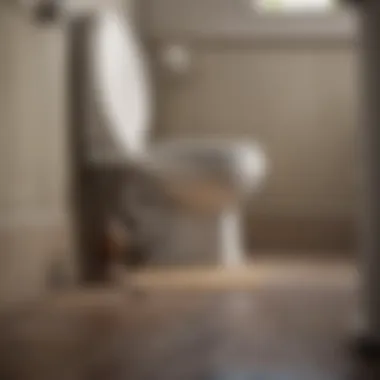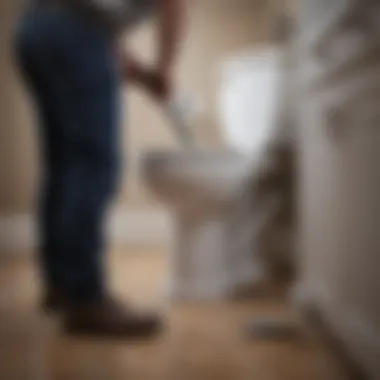Effective Methods to Unclog a Toilet Without Chemicals


Intro
Toilets represent a vital component of any home, providing convenience and hygiene. However, clogs are an unfortunate reality that can disrupt daily life. Understanding how to effectively unclog a toilet becomes essential not only for maintaining the household but also for ensuring comfort and sanitation. This article delves into practical methods for resolving toilet clogs without resorting to harsh chemicals. By emphasizing eco-friendly solutions and common household items, homeowners can effectively manage these issues.
The techniques discussed in this guide are rooted in practicality. Readers will learn about various clogging causes, preventive strategies, and several unclogging techniques that range from straightforward, do-it-yourself approaches to the usage of specialized tools.
With an informed perspective, homeowners can tackle plumbing challenges head-on. This empowers them to maintain their bathrooms efficiently while elevating their overall knowledge of plumbing.
Key Points to Discuss
- Common causes of clogs: These can stem from various sources including excessive toilet paper usage, foreign objects, or even plumbing issues.
- Preventive measures: Implementing simple habits can significantly reduce the likelihood of clogs.
- Unclogging methods: Various techniques will be explored, such as using plungers, augers, or homemade solutions.
- Professional help: Knowing when to call in an expert can save time and prevent further complications.
Overall, this comprehensive guide aims to equip readers with valuable insights and practical skills to handle toilet issues effectively.
Understanding Toilet Clogs
Toilet clogs are more than just a minor inconvenience; they can disrupt daily routines and lead to significant plumbing issues if neglected. Understanding toilet clogs serves as the foundation for effective management and prevention of such problems. This knowledge allows homeowners to identify and address these issues before they escalate.
Knowledge about toilet clogs emphasizes prevention over reaction. Recognizing the common causes helps in taking proactive measures. Furthermore, understanding how clogs work can lead to informed decisions about maintenance and tools to use.
Common Causes of Clogs
Toilet clogs can occur for various reasons. The most frequent culprits include:
- Excessive toilet paper: Many individuals underestimate the amount of toilet paper that can form a blockage. Using too much can lead to clogging, especially in older toilets, which may not have efficient flushing mechanisms.
- Foreign objects: Items such as wipes, sanitary products, and even toys can easily become lodged in the plumbing. These items do not break down like toilet paper, increasing the blockage risk.
- Flushing inappropriate materials: Items not meant to be flushed can cause clogs. While many individuals believe certain products are safe, many are misleading in their marketing.
Understanding these causes is crucial in preventing the conditions that lead to clogs.
Impact of Poor Maintenance
Poor maintenance can exacerbate the chances of a toilet clog occurring. Neglecting routine tasks, such as inspecting the toilet's components and flushing system, can invite problems. For instance, a malfunctioning flapper can lead to water drainage issues, which, in turn, may cause unflushed waste to build up.
Regular cleaning is also vital. Mineral deposits and organic growth can accumulate over time, contributing to flow issues. Therefore, it is advisable to establish a regular maintenance routine to avoid potential clogs.
Recognizing Signs of a Clog
Early detection of a clog can save time and effort. Common indicators of a clog include:
- Slow draining: If the water level rises or drains slowly rather than quickly, it may suggest a developing clog.
- Unusual noises: Gurgling sounds or irregular toilet flushing can also indicate there is an issue within the plumbing.
- Water backup: Any time waste or water backs up into the bowl or overflow, it is a clear sign that more severe action might be required.
Recognizing these signs early allows for prompt action and often resolves the problem before it escalates.
"Understanding common toilet clogging issues can help avoid costly repairs and disruptions."
By grasping the basics of toilet clogs, the homeowner not only becomes equipped to address issues but also fosters a proactive approach toward plumbing maintenance.


Immediate Solutions for Unclogging
Immediate solutions for unclogging are crucial for homeowners facing unexpected toilet issues. A clogged toilet can cause significant inconvenience and potential damage if not addressed promptly. Understanding effective methods to handle these situations will save time and reduce stress. This section provides clear, actionable techniques that allow individuals to rectify clogs without the need for harsh chemicals or calling a plumber immediately.
Using a Plunger Effectively
The plunger is often the first tool that comes to mind when dealing with a toilet clog. To use a plunger effectively, you must ensure that it is the right type. A flange plunger, specifically designed for toilets, offers the best results. Here are the steps to use a plunger:
- Position the Plunger: Place it in the toilet bowl, ensuring it covers the drain hole completely.
- Create a Seal: Push down gently to create suction before pulling upward quickly. Repeat this motion.
- Maintain Consistency: Alternate between pushing and pulling for about 20-30 seconds.
If done correctly, you should notice a change in the water level in the bowl. It may take several attempts for stubborn clogs.
Employing a Toilet Auger
When a plunger does not do the trick, a toilet auger can be effective. This tool has a long cable designed to navigate the curves of a toilet’s plumbing. To use a toilet auger, follow these steps:
- Insert the Auger: Carefully feed the auger into the toilet bowl until it reaches the obstruction.
- Crank the Handle: This will allow the cable to extend through the blockage. Apply gentle pressure to break apart the clog.
- Retrieve the Cable: Once cleared, pull the auger out slowly to avoid spilling any debris.
Using a toilet auger is often effective for tougher clogs that a plunger cannot address. However, take care during use to avoid damaging the toilet’s porcelain.
Utilizing Hot Water and Dish Soap
Hot water and dish soap provide a surprisingly effective approach to unclogging toilets. The soap acts as a lubricant, while hot water helps dissolve the clog. Here’s a step-by-step guide:
- Pour Dish Soap: Begin by adding a good amount of dish soap directly into the toilet bowl.
- Heat Water: Boil a pot of water, but ensure it cools slightly to avoid cracking the toilet.
- Combine: Slowly pour the hot water into the bowl from waist height. The increased pressure and heat work together to break down the blockage.
This method can take a bit of time, so patience is key. After a short period, flush the toilet. If successful, the water should flow freely.
Understanding these immediate solutions empowers homeowners to manage toilet clogs efficiently. Mastering these techniques can minimize reliance on professional services and enhance overall maintenance skills.
Household Items for Unclogging
Using household items for unclogging toilets is practical and cost-effective. These common ingredients, often found in kitchens, can resolve clogs without harsh chemicals. Eco-friendly methods not only reduce environmental impact but also minimize potential risks to pipes and plumbing systems. Employing these materials can be a valuable first step before resorting to more aggressive solutions.
Baking Soda and Vinegar Method
The baking soda and vinegar method is a classic approach that many find effective. The basic premise involves using these two ingredients to create a reaction that can break down grime and clogs. Begin by pouring one cup of baking soda into the toilet bowl. Follow this with two cups of vinegar. The two substances will fizz when combined. Allow this solution to sit for about 30 minutes. Once the time is up, flush the toilet. This method utilizes the natural cleansing properties of baking soda and vinegar, often allowing for a clear drain without requiring mechanical tools or chemical cleaners.
Using Salt for Clogs
Salt can also be an underestimated hero in unclogging toilets. Its abrasive properties can aid in dislodging stubborn blockages. To use salt effectively, pour a generous amount into the toilet bowl. Next, add hot water. It is essential not to use boiling water, as this could damage the porcelain. Instead, allow the salt to dissolve gradually. After 15 to 20 minutes, flush the toilet. This process can help break down clogs formed from organic materials, as well as minor buildup in pipes.
Other Kitchen Ingredients
Several other kitchen ingredients can also assist in unclogging toilets. For example, baking soda and cornstarch can be a powerful duo. Similar to the baking soda and vinegar method, adding cornstarch can improve the effectiveness of baking soda. Additionally, cola can also work as a cleaning agent due to its carbonation and acidity. Pouring cola into the toilet bowl and allowing it to sit for an hour may help to loosen debris. While it may not work for severe clogs, it can prove useful for minor issues.


- Consider these options when tackling minor clogs:
- Baking soda and cornstarch
- Cola
- Dish soap combined with hot water
Preventative Measures
Understanding the role of preventative measures is essential in maintaining a fully functioning toilet. Preventative care can save time, money, and frustration. By being proactive, homeowners can reduce the chances of experiencing a clog effectively and help sustain their plumbing system over the long term.
Common Practices to Avoid Clogs
Avoiding clogs begins with understanding what should not enter the toilet. Some of the most common practices include:
- Only flushing human waste and toilet paper: This cannot be stressed enough. Other items, including wipes, feminine products, and excessive paper, can lead to blockages.
- Educating family members: Everyone in the household must know what is acceptable to flush. This minimizes the risk of accidents caused by ignorance.
- Utilizing a wastebasket: Placing a small basket nearby for sanitary items or other waste can prevent potentially harmful materials from being flushed.
- Replacing old toilets: If your toilet is older and not designed for low-flow use, consider replacing it with a modern model that is less prone to clogs.
Regular Maintenance Checks
Conducting regular checks on your toilet can identify any potential issues before they turn into major problems. Here are some maintenance checks to consider:
- Inspect for leaks: Check around the base and the connections for any signs of water. Early detection of leaks can prevent more significant repairs later.
- Monitor flushing performance: If the flushing action seems weak, this could signify a blockage or issue in the plumbing.
- Examine the fill valve: Ensure the fill valve operates correctly, as malfunctioning can affect the overall flushing efficiency.
- Look for corrosion or wear: Regularly check for any signsof corrosion, especially around the fittings.
Identifying Risk Factors in Toilets
Specific factors can increase the likelihood of clogs in toilets. Understanding these risk factors is crucial in implementing preventative measures:
- Older plumbing systems: Aging pipes may have accumulated debris or build-up that makes clogs more likely.
- Water hardness: Hard water can leave mineral deposits in pipes, which may restrict flow and contribute to clogs over time.
- Improper installation: If a toilet is poorly installed, it may not function properly, increasing the risk of blockages.
- High volume of use: Homes with multiple users or bathrooms may experience higher instances of clogs simply due to frequency.
"Taking small, proactive steps in toilet maintenance can lead to a considerable reduction in the probability of dealing with toilet clogs."
In summary, following common practices, conducting regular maintenance checks, and recognizing risk factors can create an environment where clogs are significantly less likely to occur. Implementing these preventative measures is a key component of managing your toilet's health effectively.
Professional Help
In certain situations, dealing with a stubborn clog or recurring toilet issues requires more than just home remedies or common tools. Professional help becomes a key option here. Understanding when and why to seek assistance from a licensed plumber can save you both time and costly repairs down the line.
When a toilet blockage persists after trying standard unclogging techniques such as plungers or augers, it is wise to consider professional intervention. This is especially true when you notice signs of deeper plumbing problems, which might include frequent backups, unusual noises, or sewage odors. Ignoring these symptoms may lead to further damage, ultimately resulting in larger plumbing issues that could require extensive repairs.
Engaging a professional plumber has its distinct advantages. They possess the essential experience and specialized tools to diagnose and address complicated plumbing issues quickly. Moreover, hiring a professional reduces the risk of potential injuries that arise from improper use of tools or chemicals, which can be particularly dangerous in poorly ventilated areas.
"Ignoring persistent clogs can not only lead to inconvenience but may escalate into severe plumbing emergencies."
When to Call a Plumber
Recognizing the right moment to call a plumber is crucial for effective maintenance and repair. Here are some points to consider:
- Persistent Clogs: If your toilet becomes clogged repeatedly, even after using a plunger or auger, this indicates an underlying issue that may relate to the drainage system itself.
- Multiple Fixtures Blocked: If other fixtures in your home such as sinks or bathtubs are showing signs of clogging simultaneously, it is likely the problem is more significant than a single toilet issue.
- Unpleasant Odors: Foul smells emanating from the toilet area may suggest sewage backup, which can pose health risks and demands immediate attention from a professional.
- Water Backup: If water starts to back up into your toilet when using the sink, or if there is slow drainage, do not hesitate to call a plumber.
- Unusual Sounds: Sounds such as gurgling or bubbling coming from drains could mean air is trapped in your sewer line, pointing to a blockage that needs professional assessment.


Expected Costs of Professional Services
Understanding the costs associated with hiring a plumber can assist in budgeting for emergency repairs. The price for professional unclogging services widely varies depending on several factors:
- Severity of the Clog: Simple clogs might only cost $50 to $150 to clear. More complex issues could be between $200 to $400.
- Location: Plumbing service prices can also fluctuate based on where you live. Urban areas tend to have higher rates.
- Time of Service: If you need emergency services during off-hours or on weekends, expect additional charges.
- Diagnostics Fees: Many plumbers charge a fee to diagnose the issue, which can range from $50 to $100.
In summary, while the cost of professional help might seem daunting, it can prevent more significant issues and expenses down the road. Being informed about when to call a plumber, coupled with understanding the likely costs, arms you with essential knowledge to manage toilet repairs effectively.
Chemical Solutions
Chemical solutions for unclogging toilets can prove to be both effective and convenient. Many homeowners reach for these products during emergencies due to their quick action. However, it is essential to understand how these chemicals work, their advantages, and the possible downsides they bring.
Understanding Chemical Drain Cleaners
Chemical drain cleaners come in different formulations, primarily categorized into three types: alkaline, acidic, and enzymatic.
- Alkaline Cleaners - These cleaners often contain sodium hydroxide or potassium hydroxide and work by generating heat through a chemical reaction when mixed with water. This heat helps dissolve clogs made of organic matter.
- Acidic Cleaners - These products usually include sulfuric acid or hydrochloric acid. They are quite powerful and can dissolve tough blockages, such as hair or grease. However, they require careful handling due to their corrosive nature.
- Enzymatic Cleaners - These solutions contain bacteria or enzymes that biologically break down organic material over time. They are less aggressive and considered safer for pipes but may take longer to show effects.
While chemical drain cleaners can provide quick relief, understanding their specifics is key in selecting the appropriate one for your needs.
Risks and Considerations
Using chemical solutions involves certain risks and considerations. Here are important points to keep in mind:
- Pipe Damage: Harsh chemicals can erode pipes over time, especially if used frequently. This damage can lead to more significant plumbing issues down the line.
- Environmental Concerns: Many commercial cleaners contain ingredients that can harm the environment. Consider their impact if you are environmentally conscious.
- Health Hazards: Exposure to fumes or contact with skin can lead to health issues. Always wear protective gear and follow usage instructions on product labels.
Using chemical solutions effectively requires attention to safety and long-term consequences.
- Effectiveness: Not all clogs will respond to chemical cleaners, particularly those caused by foreign objects. In such cases, mechanical methods may be necessary.
- Cost: Chemical drain cleaners are generally affordable but can add up if you find yourself needing them regularly. Investing in preventative measures can save money in the long run.
Culmination
Understanding how to effectively unclog a toilet and maintaining it properly are essential skills for any homeowner or design enthusiast. This section synthesizes the previous content, emphasizing key techniques and habits that contribute to long-term toilet health and performance.
Summarizing Effective Unclogging Techniques
Several methods to unclog a toilet have been discussed, each with its unique benefits. Utilizing a plunger is often the first step in dealing with a blockage. It is effective and straightforward.
Employing a toilet auger can reach clogs that a plunger cannot. This tool can be necessary when faced with stubborn blockages, offering deeper access to the toilet's drain. Using household items like baking soda and vinegar or hot water and dish soap is not only eco-friendly but also cost-effective. These strategies minimize the use of harsh chemicals while maintaining the plumbing system's integrity.
An important point to remember is to act quickly when a clog is recognized. Delaying action can lead to more serious plumbing issues, potentially increasing repair costs.
Fostering Proper Maintenance Habits
Preventative maintenance is an integral part of managing toilet performance. For instance, being mindful of what goes down the toilet can prevent clogs in the first place. Regularly inspecting the toilet for any signs of wear can prevent future problems, giving peace of mind in day-to-day living.
Encouraging proper flushing habits can also reduce clogs. Avoid flushing non-biodegradable items or excessive amounts of toilet paper. Educating everyone in the household about the correct practices fosters a collective effort to maintain the plumbing.
Adopting a routine maintenance schedule for checking toilet functionality and conducting simple cleaning can prolong the life of the toilet bowls and reduce incidences of clogs.
To summarize, efficient unclogging methods combined with consistent maintenance practices will keep a toilet functioning optimally and minimize unexpected plumbing crises. These steps not only save time and money but also reinforce the importance of responsible homeownership.







